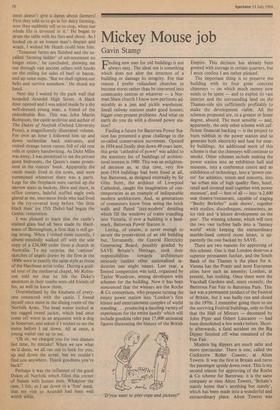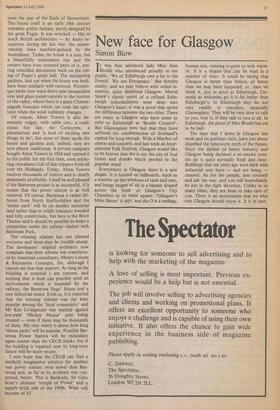Mickey Mouse job
Gavin Stamp
'`Incling new uses for old buildings is not always easy. The ideal use is something which does not alter the structure of a building or damage its integrity. For that reason I prefer redundant churches to become stores rather than be converted into community centres or whatever — a Nor- man Shaw church I know now performs ad- mirably as a jam and pickle warehouse. Small railway stations make good houses; bigger ones present problems. And what on earth do you do with a disused power sta- tion?
Finding a future for Battersea Power Sta- tion has presented a great challenge to the so-called conservation movement. Opened in 1934 and finally shut down 49 years later, this great 'cathedral of power' was added to the statutory list of buildings of architec- tural interest in 1980. This was an enlighten- ed decision as, at that time, very few post-1914 buildings had been listed at all, but Battersea, as designed externally by Sir Giles Scott, the architect of Liverpool Cathedral, caught the imagination of con- temporaries as an example of indisputable modern architecture. And, as generations of commuters know from seeing the brick walls and fluted `jazz-modern' detailing which fill the windows of trains trundling into Victoria, if ever a building is a land- mark, Battersea Power Station is.
Listing, of course, is never enough to secure the preservation of an old building but, fortunately, the Central Electricity Generating Board, possibly goaded by SAVE Britain's Heritage, took their responsibilities towards architecture seriously (unlike other nationalised in- dustries one might name). Last year, a Timited competition was held, organised by Taylor Woodrow, among developers with schemes for the building. Now it has been announced that the winners are the Roche & Co consortium, who propose turning the empty power station into 'London's first leisure and entertainment complex of world standing . . . producing a dazzling variety of experiences for the entire family' which will include gondola rides past 17,000 animated figures illustrating the history of the British
D'you want to play cops and pickets?'
Empire. This decision has already been greeted with outrage in certain quarters, but I must confess I am rather pleased.
The important thing is to preserve the building with its four great concrete chimneys — on which much money now needs to be spent — and to exploit its vast interior and the surrounding land on the Thames-side site sufficiently profitably to make the development viable. All the schemes proposed are, to a greater or lesser degree, absurd. The most sensible — and, apparently, the only other scheme with suf- ficient financial backing — is the project to burn rubbish in the power station and so generate both electricity and heat for near- by buildings. An additional merit of this scheme is that the chimneys will continue to smoke. Other schemes include making the power station into an exhibition hall and museum, into a conference centre and an exhibition of technology, into a 'power cen- tre' for athletics, tennis and concerts, into `an urban mix of high quality flats, hotel, retail and covered mall together with power museum', and — best of all — into 'a 2,600 seat theatre/restaurant, capable of staging "Busby Berkeley" scale shows', together with studios, discotheques, restaurants, an ice rink and 'a leisure development on the pier'. The winning scheme, which will turn the two vast turbine halls into a 'fantasy world' while keeping the extraordinary marble-lined control room intact, is ap- parently the one backed by SAVE.
There are two reasons for approving of this scheme. One is that London deserves a superior permanent funfair, and the South Bank of the Thames is the place for it. Vienna has the Prater and most European cities have such an amenity; London, at present, has nothing. Once there were the Vauxhall Gardens and, more recently, the Battersea Fun Fair in Battersea Park. This last was a permanent product of the Festival of Britain, but it was badly run and closed in the 1970s. I remember going there to see the surviving Festival buildings, only to find that the Hall of Mirrors — decorated by John Piper and Osbert Lancaster — had been demolished a few weeks before. Short- ly afterwards, a fatal accident on the Big Dipper finished off what remained of the Fun Fair.
Modern big dippers are much safer and more spectacular. There is one, called the Cockscrew Roller Coaster, at Alton Towers. It was the first in Britain and turns the passenger upside down twice. This is my second reason for approving of the Roche & Co scheme for Battersea: it is the same company as runs Alton Towers, 'Britain's stately home that's anything but stately', which has been made into a wonderful and extraordinary place. Alton Towers was
once the seat of the Earls of Shrewsbury. The house itself is an early 19th century romantic gothic fantasy, partly designed by the great Pugin. It was wrecked — like so much British architecture — by Army oc- cupation during the last war: the conser- vatories were machine-gunned by the Australians. Today the house is a ruin, but a beautifully maintained one and the owners have even restored parts of it, put- ting stencilled decoration back on the ceil- ing of Pugin's great hall. The enchanting gardens, laid out when the house was built, have been similarly well restored. Pictures- que paths now wind down past immaculate iron and glass conservatories to the bottom of the valley, where there is a giant Chinese- pagoda fountain which can soak the spec- tator when the wind suddenly changes.
Of course, Alton Towers is also im- mensely vulgar, with cable cars, a tradi- tional fun fair, the Corkscrew, a planetarium and 'a host of exciting new things to do', but none of these spoils the house and gardens and, indeed, they are now almost traditional. A private company bought Alton Towers in 1924 and opened it to the public for the first time, soon attrac- ting charabancs full of day-trippers from all over the Midlands. Today, Alton Towers receives thousands of visitors and is clearly immensely profitable. I shall be well pleased if the Battersea project is as successful, if it means that the power station is as well restored. Of course, Battersea is rather dif- ferent from North Staffordshire and the 'theme park' will be on derelict industrial land rather than in wildly romantic wooded and hilly countryside, but here is the River Thames and it should be possible to make a connection under the railway viaduct with Battersea Park.
The winning scheme has not pleased everyone and there may be trouble ahead. The developers' original architects now complain that their scheme was transform- ed by American consultants, Messrs Leisure & Recreation Concepts, Inc, although I cannot see that that matters. As long as the building is restored I am content, and nothing that is built can possibly spoil an environment which is bounded by the railway, the Battersea Dogs' Home and a new industrial estate. Even so, it is reported that the winning scheme was the least popular among the 'local community' and Mr Ken Livingstone was warned against low-paid 'Mickey Mouse' jobs being created — even if there may be thousands of them. My only worry is about how long 'theme parks' will be popular. Possibly Bat- tersea Power Station will be redundant again sooner than the CECB thinks, but if the building is repaired now its long-term future will be more secure.
I now hope that the CEGB can find a similarly imaginative solution for another vast power station: even newer than Bat- tersea and, as far as its architect was con- cerned, better. This is Bankside, Sir Giles Scott's ultimate 'temple of Power' and a superb brick pile of the 1950s. What will become of it?















































 Previous page
Previous page